Locations of Interest
Several key historical sites within the Williamsburg Chapter's area are especially meaningful to the SAR. We have compiled short descriptions, photos and noted SAR activities at each location.
Click on the shortcuts to the right to learn more about each location on this webpage, or use the Google Map above to access the same information in an interactive format.
We recommend you enlarge the Google Map by clicking on the expand button ![]() found in the top right corner of the map. This feature will open the map in a full browser window.
found in the top right corner of the map. This feature will open the map in a full browser window.
To navigate the map, use the menu ![]() found on the left side of the map, or simply click on each site marker to access the description and photos provided. Zoom in and out of the map using your mouse's scroll feature or with the +/- buttons found in the bottom corner of the map.
found on the left side of the map, or simply click on each site marker to access the description and photos provided. Zoom in and out of the map using your mouse's scroll feature or with the +/- buttons found in the bottom corner of the map.
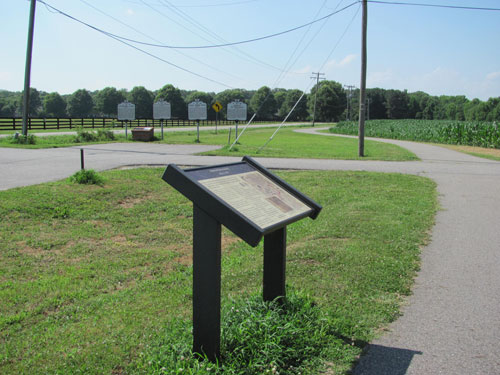
Battle of Green Spring (Historical Marker)
Located along the Virginia Capital Trail, parallel to Greensprings Road, a historical marker commemorates the Revolutionary Battle of Green Spring which occurred on July 6, 1781 between 5,000 British troops and 900 American soldiers.
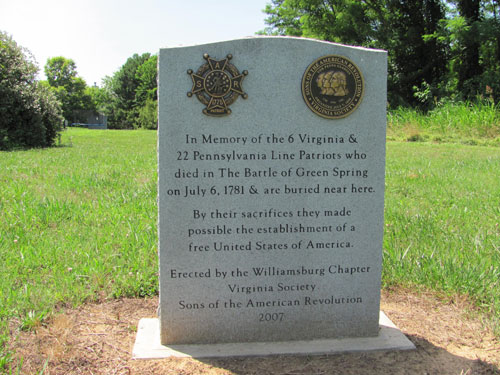
Battle of Green Spring (Memorial)
The Sons of the American Revolution have placed the pictured memorial in honor of the patriots who died at the Battle of Green Spring (July 6, 1781) near the Church on the Main. The church which was built around 1683 as the successor to the original church at Jamestown, and is near the battlefield.
Each July the Williamsburg Chapter of SAR holds a commemorative ceremony to honor the 6 Virginia and 22 Pennsylvania Line patriots who died during the battle.
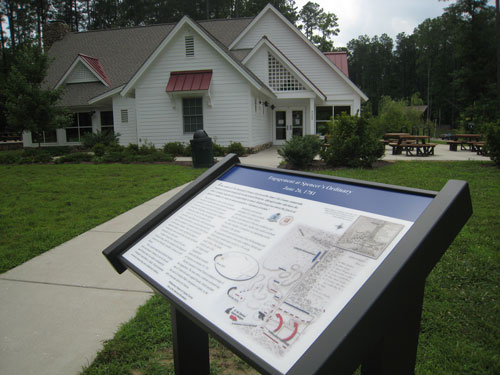
Engagement at Spencer’s Ordinary (Historical Marker)
Freedom Park, a James City County recreational park, is the location of the June 26th, 1781 Revolutionary Engagement at Spencer's Ordinary where several skirmishes took place between light detachments from the armies of General Lord Cornwallis and the Marquis de Lafayette. They clashed near a tavern (the "ordinary") at a road intersection not far from Williamsburg.
The Williamsburg chapter holds a commemoration in June outside the Freedom Park Interpretive Center. The marker shows the positions of the opposing forces during the engagement.
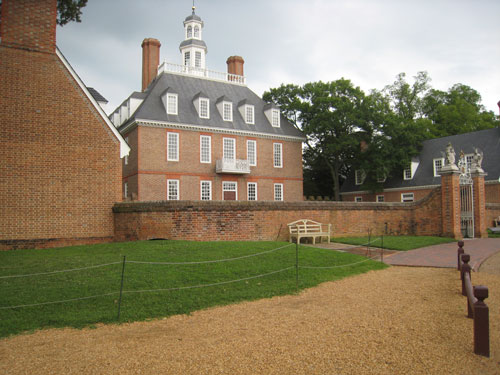
Governor’s Palace
The Governor’s Palace is located in Colonial Williamsburg, where it served as the residence for the Royal Governors of the Colony of Virginia from 1710 until the capital was moved to Richmond in 1780. It burned down in 1781 while being used as a hospital for care of the wounded from the Siege of Yorktown. It was rebuilt in the 1930’s as a part of the restoration of Colonial Williamsburg. The Williamsburg Chapter of SAR participates in several commemorative ceremonies at the Palace each year.
The Williamsburg Chapter participates with Colonial Williamsburg in their annual Memorial Day Wreath Laying ceremony and parade. The chapter provides the color guard, and along with the Thomas Nelson, Jr. Chapter, VASSAR and DAR present commemorative wreaths.
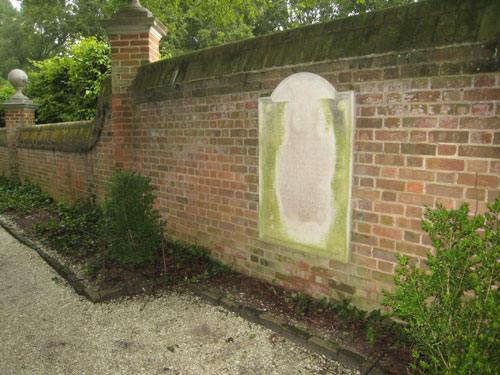
Revolutionary War Burial Ground
156 Revolutionary war veterans of several nationalities, mostly French, and including two women, are buried in the garden behind the Governor's Palace in Colonial Williamsburg. In 1781, the palace was being utilized as a hospital for the wounded from the Battle of Yorktown. The graves, located near the palace, contain the remains of those patriots who died as a result of their wounds, or disease.
The Williamsburg Chapter holds a ceremony on Veterans Day when it places a wreath in the Revolutionary War Cemetery at the Governor’s Palace to honor those patriots buried there.
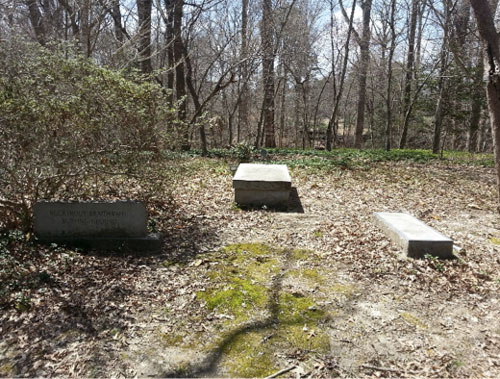
French Soldiers Cemetery
This small cemetery, near the Williamsburg Inn, in Colonial Williamsburg contains the remains of several French soldiers killed while aiding American forces during the Revolutionary War. The Williamsburg Chapter places a wreath at this site during the annual Memorial Day Observances in Colonial Williamsburg.
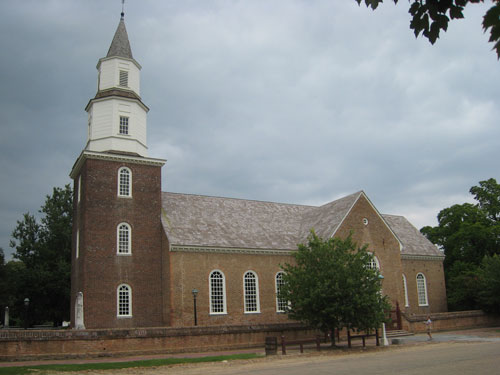
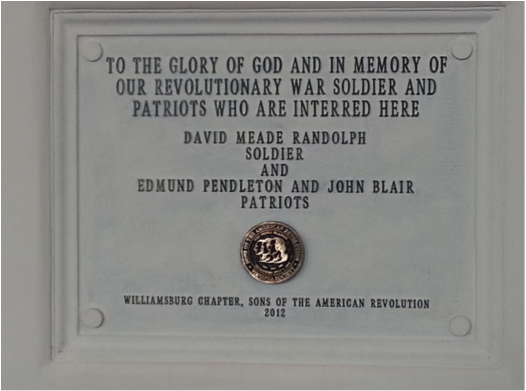
Bruton Parish Episcopal Church
Bruton Parish Church, in Colonial Williamsburg, has been restored to the colonial era, and name plates on its box pews commemorate famous worshippers from the time, including George Washington, James Madison, John Tyler, Benjamin Harrison, Patrick Henry, and Thomas Jefferson. The church still uses a bell cast in 1761, which rang to celebrate the signing of the Declaration of Independence in 1776 and the signing of the Treaty of Paris in 1783, marking the end of the American Revolutionary War.
The pictured plaque was donated to the church by the Williamsburg Chapter SAR to commemorate the soldiers and patriots who are buried there. The Williamsburg Chapter participates in a ceremony on Memorial Day honoring these patriots.
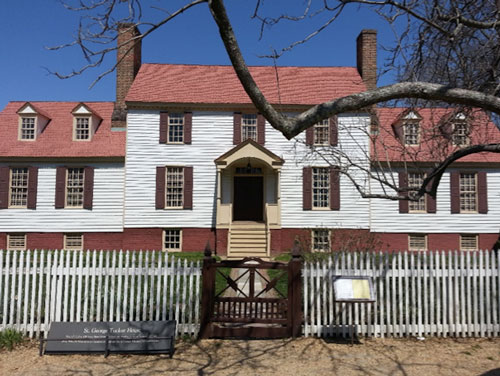
St. George Tucker House
The home of St. George Tucker, who personally participated in the Bermuda Gunpowder Plot in August of 1775 which resulted in 100 barrels of gunpowder passing into the hands of the American forces, is located in Colonial Williamsburg. LtCol. Tucker served in the militia and was wounded at the Battle of Guilford Courthouse and again at the siege of Yorktown. He later became a prominent attorney and judge.
In 2014 NASSAR President General Lindsey C. Brock, and members of the Williamsburg Chapter of SAR along with other SAR and DAR representatives participated in ceremonies honoring St. George Tucker and the other members of the Bermuda Gunpowder Plot.
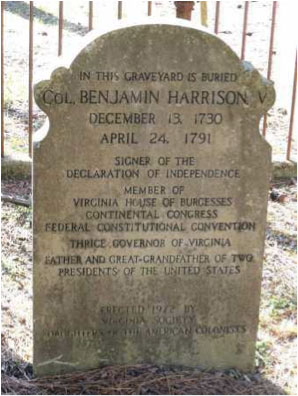
Berkeley Plantation
Berkeley Plantation, one of the first great estates in America, comprises about 1,000 acres on the banks of the James River on State Route 5 in Charles City County. Benjamin Harrison IV built what is believed to be the oldest three-story brick mansion in Virginia and is the ancestral home to two Presidents of the United States: William Henry Harrison, his grandson, and Benjamin Harrison his great-great-grandson.
The Williamsburg Chapter of SAR participates in the Williamsburg Chapter of DAR sponsored memorial ceremony on the 4th of July at the grave of Benjamin Harrison V.
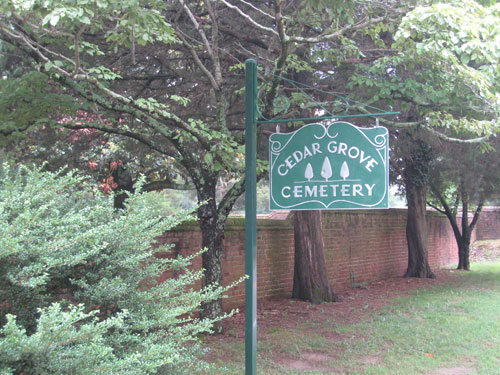
Cedar Grove Cemetery
Cedar Grove Cemetery, while founded in 1859, contains the remains of several Revolutionary War soldiers who have been re-interred from other locations.
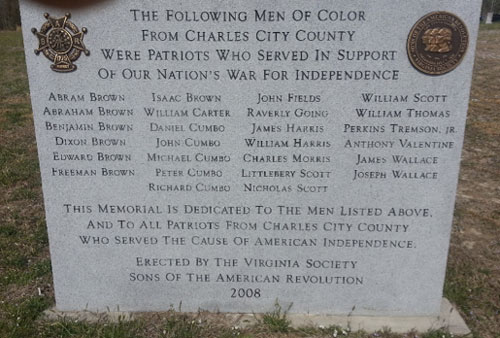
Old Elam Cemetery
A memorial dedicated to 26 patriot men of color from Charles City County who served in support of the Revolutionary War can be found in Old Elam Cemetery in Charles City. The Williamsburg Chapter SAR participated in the monument dedication in 2008, along with other state chapters and NASSAR.
Historic Jamestown
Jamestown was the first permanent settlement in America. Founded as an economic venture by the Virginia Company in 1607. It ceased to exist as a settlement in 1699 when the capital of Virginia was moved to Williamsburg. The original location is now a National Park, and is an active archaeological site. Close by, Jamestown Settlement is an interpretive museum and visitors center where 17th century Virginia comes to life.
Colonial Williamsburg
Colonial Williamsburg is a living-history museum and private foundation representing the historic district of the city of Williamsburg, Virginia. The 301-acre Historic Area is an interpretation of a Colonial American city, with exhibits including dozens of authentic or re-created buildings related to colonial and American Revolutionary War history.
Yorktown Battlefield
In October 1781, Yorktown was the site of the final major battle of the Revolutionary War. After this defeat, the British government changed, and as a result, began to negotiate the Treaty of Paris which was ultimately signed in September 1783. The battlefield is now a National Park, and there is a comprehensive history center nearby. The Thomas Nelson Jr. Chapter of SAR, along with NASSAR and VASSAR and the Williamsburg Chapter SAR participate annually in the Yorktown Days commemoration of the victory. Ceremonies include laying wreaths on the tomb of Thomas Nelson Jr., and a parade.
